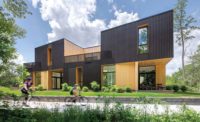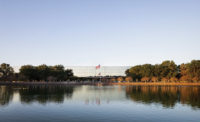The offspring of an academic institution and a laboratory that develops systems for national security, the Massachusetts Institute of Technology Beaver Works straddles two different worlds: one that prizes transparency and another that requires locked doors. The program, which began five years ago using existing classrooms and labs at MIT, moved into its first proper home at the end of 2013. Designed by Boston-based Merge Architects, the new 4,900-square-foot space in an office building just off the MIT campus serves as an academic outpost for a laboratory shrouded in secrecy and a place where college seniors can get a taste of defense-oriented research and development.
Beaver Works serves the dual purpose of exposing students to the kind of work done at Lincoln Lab and giving Lincoln a toehold near the MIT campus that can help it recruit students for future employment. Now that technology companies such as Google and Twitter are chasing top engineering students and offering contemporary workspaces as part of the deal, Lincoln Lab realized it needed to compete for talent in a new way. So Beaver Works breaks from the mold of both academic and research facilities, neither of which exerts much sex appeal for recent graduates. Robert Shin, the director of Beaver Works and the head of the Intelligence, Surveillance and Reconnaissance and Tactical Systems Division at Lincoln Lab, knew from the start that design would be an important aspect of the project. “It had to be a place where people wanted to be,” he says.
Shin took a risk by hiring Merge, a young firm headed by Elizabeth Whittaker that had designed restaurants, bars, and residences aimed mostly at professionals in their 20s and 30s. The creative tension between Whittaker's contemporary aesthetic and Beaver Works' academic roots generated an intriguing design. “We wanted it to have a garage-like feeling,” says Shin, but Whittaker made it more refined, with sharp graphics, clean lines, and sleek steel-framed tables and work surfaces. At the same time, Whittaker's interest in fabrication dovetailed nicely with Beaver Works' emphasis on learning by making.
“In our work, we try to test out new ways of putting things together,” says Whittaker. Custom fabrication and unusual applications of common elements are often key strategies. For example, she used woven cotton straps to define partitions in a restaurant and created a wall made of 40,000 wooden dowels for a loft. For Beaver Works, she designed built-in seating made of radiata pine plywood, a system of mobile storage carts, and a teaching area that can be divided into two classrooms with a movable partition. Tables and chairs sit on wheels, so they can move too.
Shin had originally figured he would need 10,000 square feet for the project. But the place he ended up renting—just part of a floor in a tech office building—is half that size, requiring Whittaker to design spaces to accommodate multiple uses or change configuration.
Expressing the dual nature of Beaver Works as a program for transmitting knowledge and exploring national defense technologies, Whittaker's design creates a fine balance between transparency and enclosure. From the generic building corridor that leads to the facility, visitors first see a large photograph of Lincoln Lab's main complex in Lexington and the Beaver Works' logo emblazoned on an angled wall. Vertical slots of glass in the wall provide peeks into the space beyond. Enter through a glass door and you find yourself in a lounge punctuated by a freestanding counter with stools and a sink. Built-in plywood seating topped with cushions and a pair of suspended light fixtures made of wood and felt give the space a welcoming feeling. A wall of glass looks onto a workspace, creating the illusion of openness. Anyone can grab a cup of coffee and sit in the lounge or head to the adjacent classrooms, but only students, faculty, and people with permission can cross over to the laboratory workspace on the other side of the glass partition.
In the lab area, the movable storage carts can dock along one wall or sidle up to raw-steel rolling desks. An angular plywood pod with upholstered benches provides a semi-private place for people to meet, work, or even take a nap (as one student was doing when this writer visited). Color activates and unifies the various parts of the project, with school bus yellow providing a sharp contrast to plywood surfaces, polished-concrete floors, and dark-gray ceilings. A faceted ceiling in the classrooms at one end of the project snakes along an edge of the lounge and into the lab, connecting the three major areas. A separate prototyping shop equipped with 3-D printers and other tools is a short walk down the corridor from the main Beaver Works space.
Many new workplaces created for fast-growing tech companies feel like corporate clichés, generic in their deployment of whimsical colors, beanbag chairs, and bleacher stairs. Beaver Works may have a slightly goofy name and lots of stuff that moves—however, it's anything but a playground. It's a place for learning and making that appears bigger than it really is and more open than security allows.
PeopleClient: MIT Lincoln Laboratory Beaver Works Owner: Massachusetts Institute of Technology Architect: Personnel in architect's firm who should receive special credit: Engineers: Structural: Evan Hankin General contractor: J. Calnan and Associates, Inc. Photographer: Size: 4,900 square feet Construction cost: withheld Completion date: November 2013 |
ProductsGlazing Doors Metal doors: Studco Building Systems Wood doors: Studco Building Systems Sliding doors: Studco Building Systems Hardware Pulls: Interior finishes Cabinetwork and custom woodwork: Paints and stains: Benjamin Moore Plastic laminate: Solid surfacing: Trespa (Lab Table Tops) Floor and wall tile: Existing concrete slab, polished throughout Furnishings Reception furniture: Herman Miller (Eames tables) Tables: Steelcase Lighting Downlights: Lightolier Task lighting: Philips Ledalite Plumbing Lab Faucets: Chicago Faucets Sinks: Just Manufacturing Company Other unique products that contribute to sustainability: Radiatta Pine Plywood (Millwork): All FSC certified |
















Post a comment to this article
Report Abusive Comment